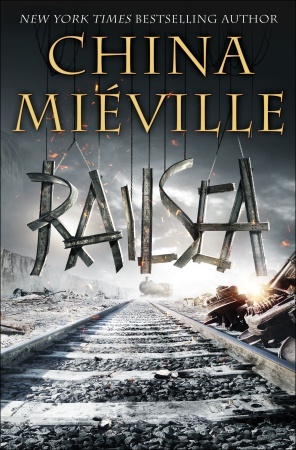
Book talk: Life on the railsea is not easy: bad tracks, traps laid by pirates, and attacks from below claim many lives. But Sham is grateful for his job aboard the Medes. At least he is finally seeing the world outside his home town. Hunting giant moles can be exciting and people say that he should be proud to serve under a captain with her own Philosophy--an ivory colored creature she pursues with a passion and who has already taken her arm. Sham wants something more though and his vague sense of unease finds a focus when he discovers a picture of the impossible: a place where the great tangle of the railsea condenses into a single track. But while the captain's nemesis is certainly deadly, Sham soon discovers that secrets are the most dangerous quarry of all.
Rocks my socks: The world-building in this novel was the most creative and thorough I have read in a while. The way the environment has changed affects everything from how people earn a living to what creatures exist to the written and spoken language. Whole industries have cropped up around salvaging technology from the more prosperous past and the pollution that has seeped into the ground has created mutant creatures that thrive in the empty wastelands between cities. The captain is reminiscent of Captain Ahab, but the story isn't a simple re-working of Moby Dick. In this world there are many captains like Ahab and it's become a trend to have a 'philosophy,' a specific creature that has wronged a captain and which the captain has sworn to hunt until one or both of them dies. They often gather at pubs to tell their stories and there's a museum to chronicle the captains who have been successful in their philosophy hunts. This is only part of the story of Railsea though, and Mieville mainly includes it to lambast the idea. I am a fan of books that use slang and dialect to help set an atmosphere for a story so I loved the language in this novel and how connected it is to the world-building. There were many distinctive characters to enjoy as well and I naturally enjoyed the fact that Sham nurses a bat that becomes his companion and helps him along the way.
Rocks in my socks: Mieville is a wonderful and highly opinionated author, but he doesn't always weave those opinions in seamlessly. He was far from subtle in the points he wanted to make, and it often felt preachy to me. After a lengthy book where I got attached to the characters and lost in their world the end was basically just a cheap shot about the greed of big businesses. I don't necessarily disagree with him, but making that the climax made the whole plot seem cheap and pointless. Even though I absolutely adored most of the novel, the ending left me with such a bad taste that it soured the whole novel for me.
Every book its reader: I'd give this to science fiction fans looking for something with intricate world-building or those looking for a new take on Moby Dick. The world-building, though wonderfully imaginative, throws you in the deep end instead of slowly acclimating you. This, combined with the dialect make it difficult to get into, so I'd save it for more advanced readers. It can be violent at times, so I'd save it for 7th grade and up.
Extras:
China Mieville has his own site
There's an interview with Mieville about the book on Boing Boing
There's a trailer for the book, although I'm not sure how well comparing the book to Moby Dick will sell it to teens:
Source: school library
Bonus Quotes:
“People have wanted to narrate since first we banged rocks together & wondered about fire. There’ll be tellings as long as there are any of us here, until the stars disappear one by one like turned-out lights.”
“Humans like nothing more than to pigeonhole the events & phenomena that punctuate their lives.”
“There was a time when wen we did not form all our words as we do now, in writing on a page. There was a time when the word "&" was written with several distinct & separate letters. It seems madness now. But there it is, & there is nothing we can do about it.
Humanity learned to ride the rails, & that motion made us what we are, a ferromaritime people. The lines of the railsea go everywhere but from one place straight to another. It is always switchback, junction, coils around & over our own train-trails.
What word better could there be to symbolize the railsea that connects & separates all lands, than “&” itself? Where else does the railsea take us, but to one place & that one & that one & that one, & so on? & what better embodies, in the sweep of the pen, the recurved motion of trains, than “&”?
An efficient route from where we start to where we end would make the word the tiniest line. But it takes a veering route, up & backwards, overshooting & correcting, back down again south & west, crossing its own earlier path, changing direction, another overlap, to stop, finally, a few hairs’ width from where we began.
& tacks & yaws, switches on its way to where it’s going, as we all must do.”
Railsea by China Mieville: buy it or check it out today!
No comments:
Post a Comment